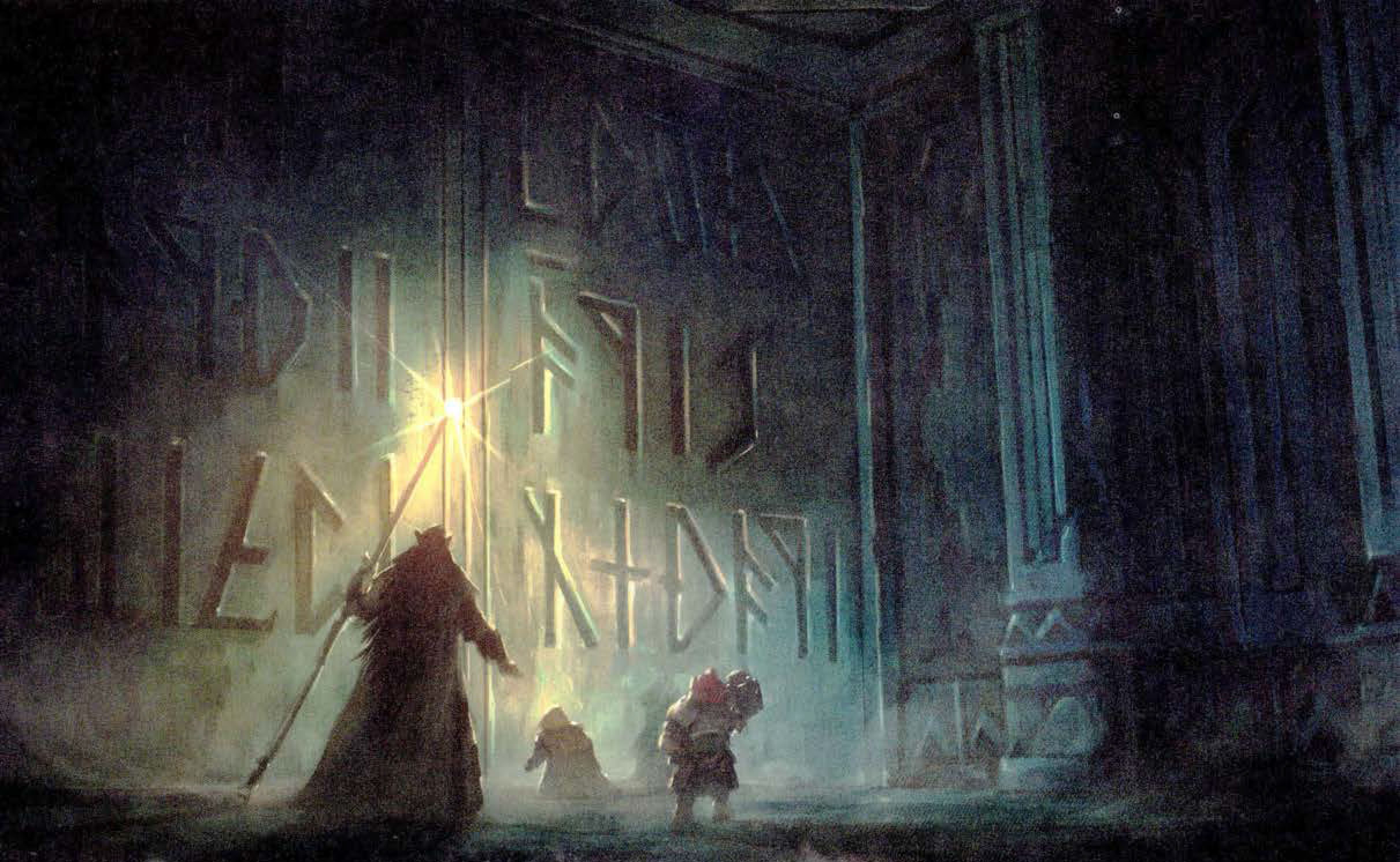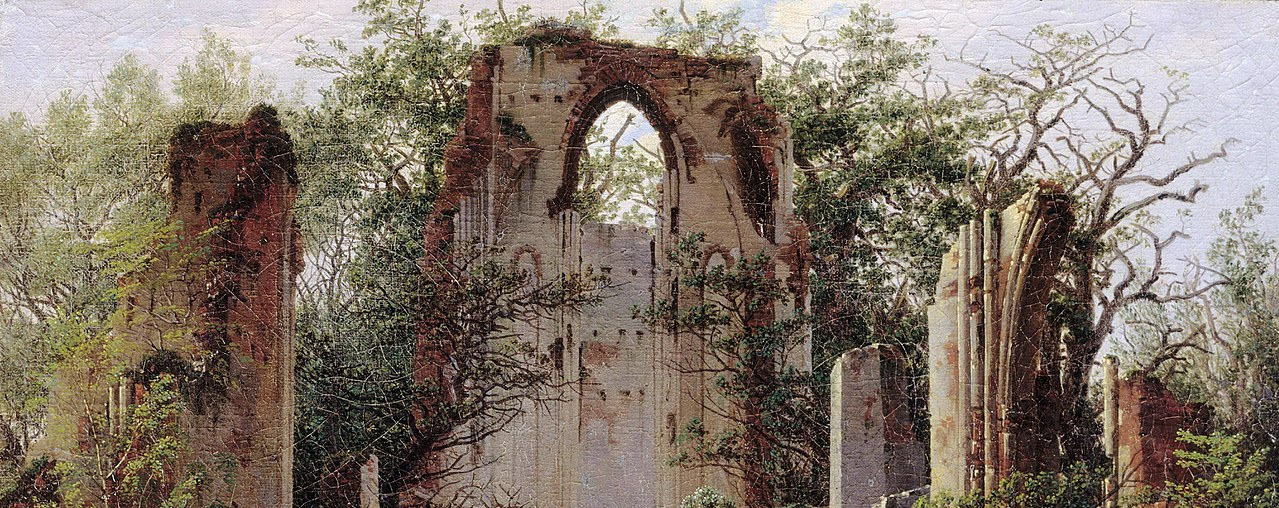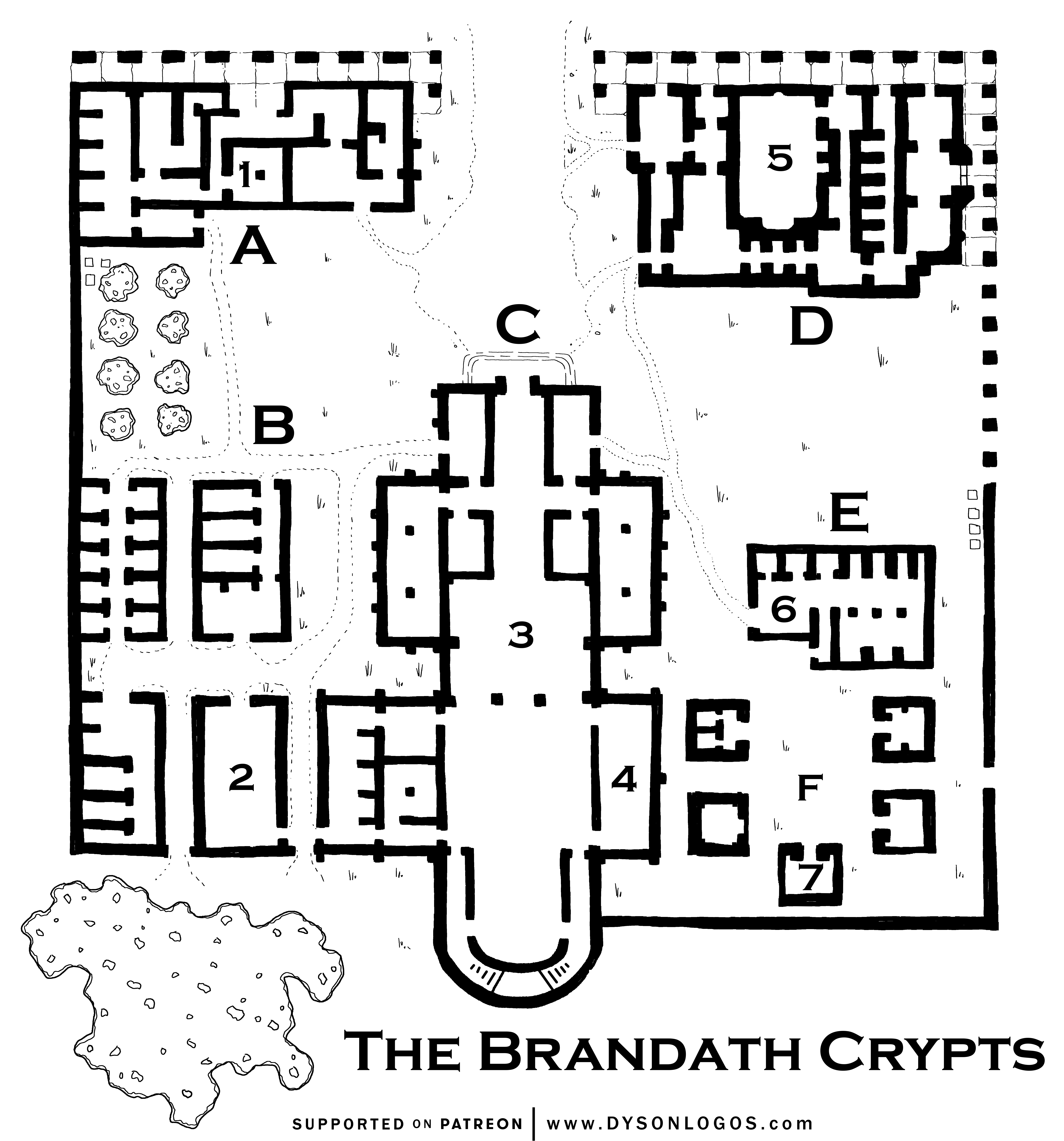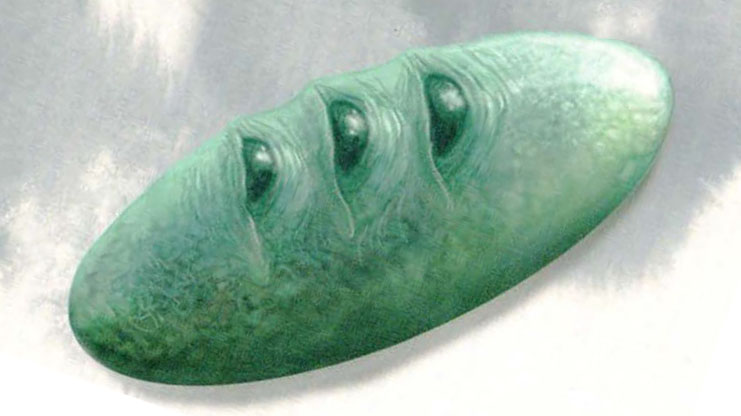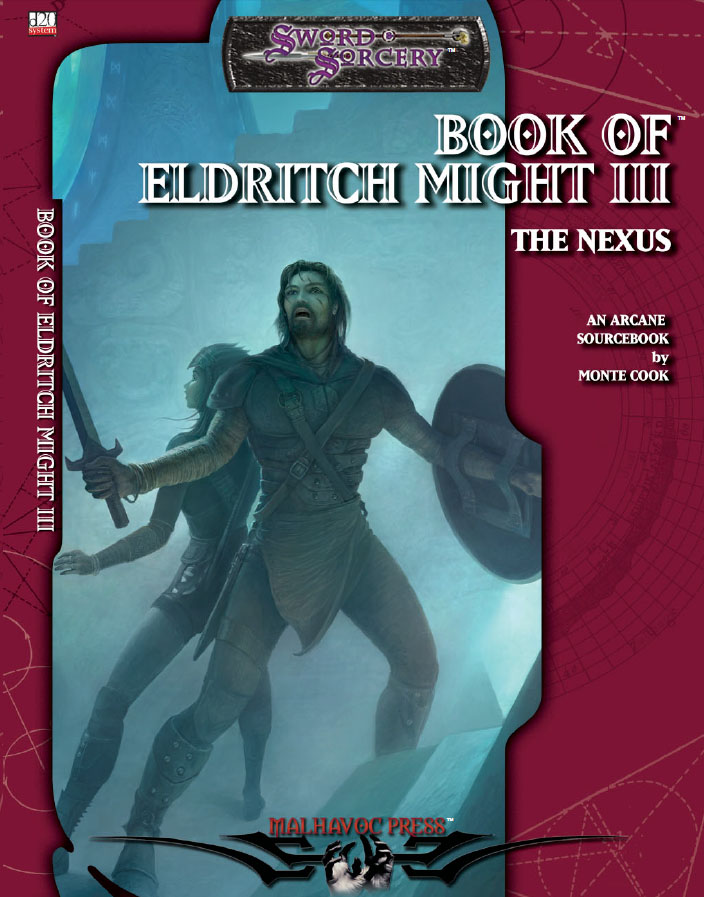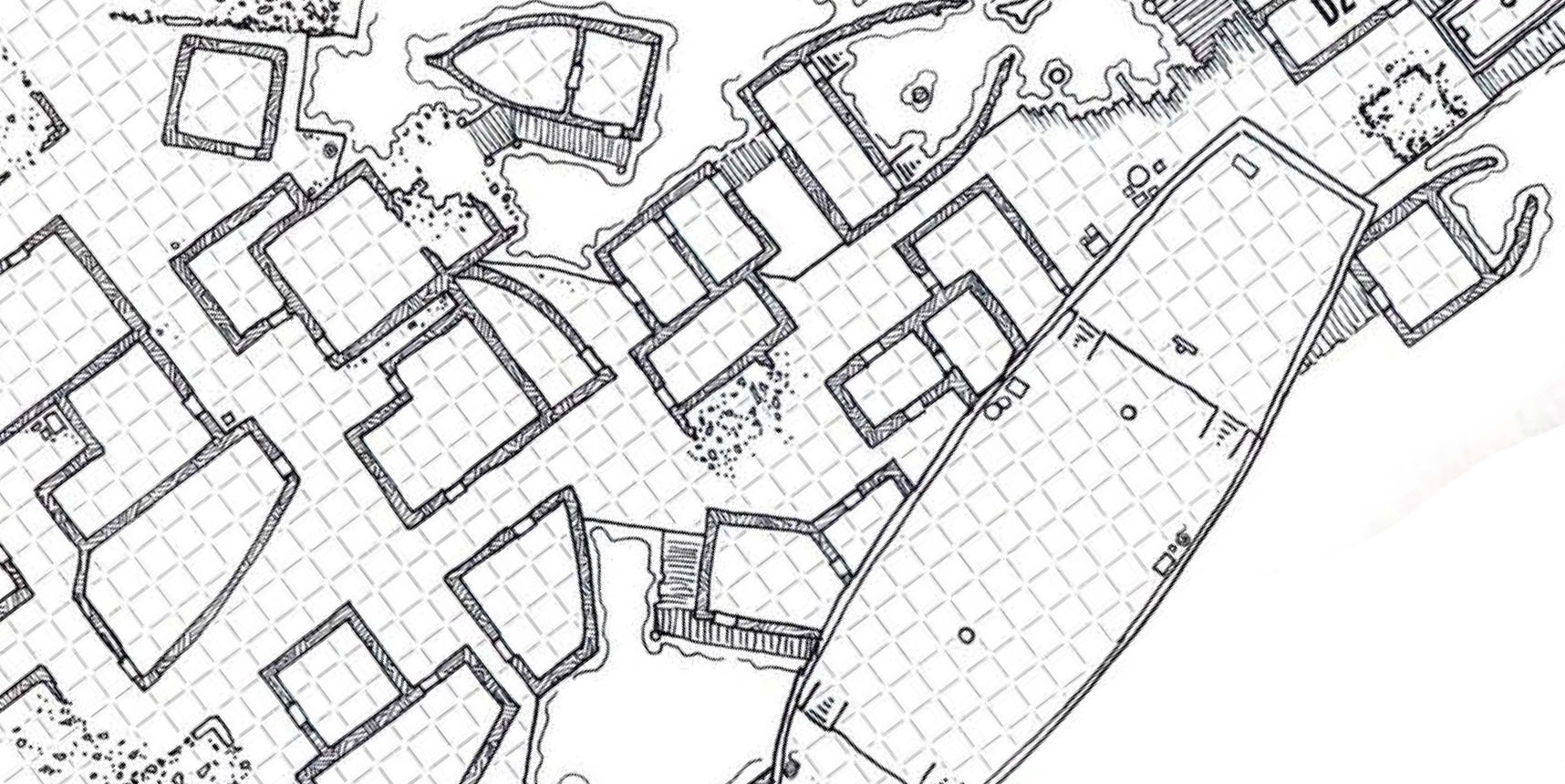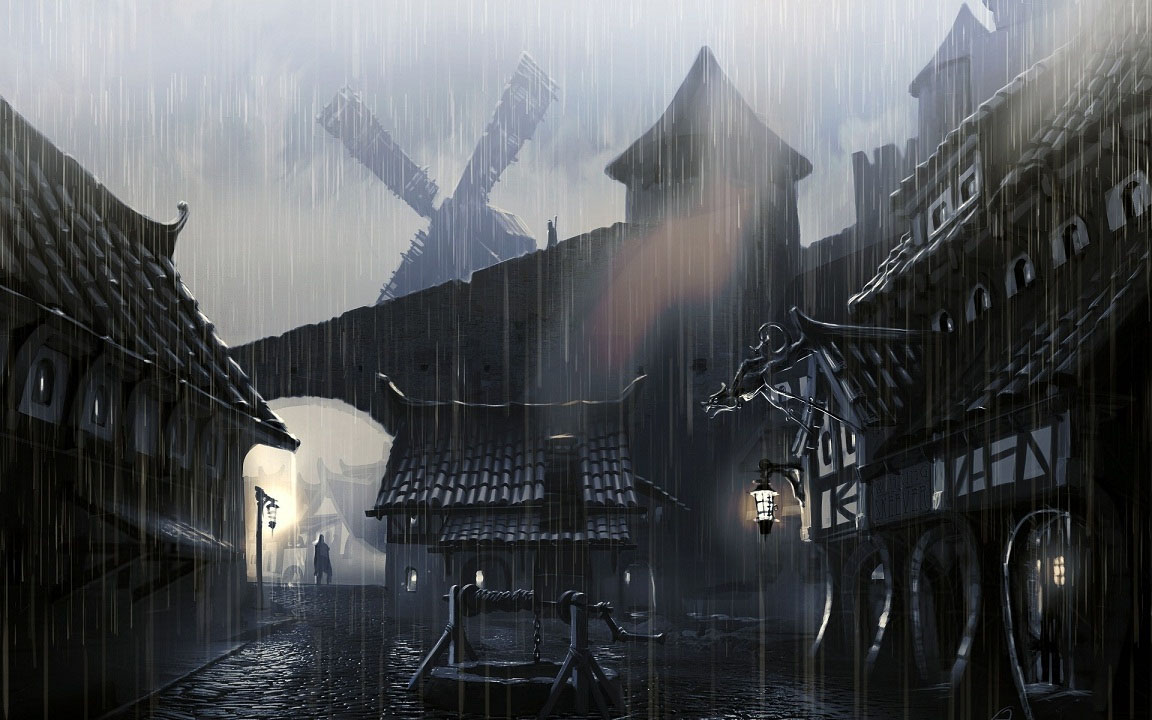The entries here modify or replace those found on p. 94-97 of Dragon Heist. They reference the map on p. 95.
THE HALL OF SECRETS
About 15 feet down the sloping hallway, the stone construction changes. To anyone knowledgable about such things, the lower portion of the hall is clearly dwarven construction.
Roughly 50 feet beyond that, the walls of the hall are covered with what appear to be dwarven graffiti — some painted on the walls, others carved. Each records a secret, most of them banal (“my beard quivers for Lorlai of the stonecutters,” “I tasted pixy dust in the third hall,” “I use rotgrub paste to dye my beard”).
This continues for another two hundred feet before the hall ends in Area V1.
DOOR OF THE CEREMONIAL VAULT
AREA V1 – ANTECHAMBER: The antechamber is twenty feet wide and twenty feet high. It seems to resonate with a silent stillness, suggestive of its great age. The far wall is dominated by a massive pair of adamantine doors bearing dwarvish runes taller than a grown man. In the center of the floor there is a bronze bas relief of a stylized sun, six feet across. Words have been carved into the floor in a circle around the bas relief.
- The Doors: The dwarvish runes read, “All that lies within belongs to the Silent Keeper.” The doors cannot be forced open or damaged in any way, and attempts to circumvent them with magic short of a wish spell fail automatically.
- The Sun: The script running around the sun is in Chondathan (the local human tongue) and, upon inspection, clearly a more recent addition to the antechamber. The inscription reads, “Know ye the hidden truth.” It’s repeated three times.
- Opening the Doors: It’s a ceremonial vault and opening the doors requires the performance of a ceremony: A single dragonscale must be laid upon the bas relief of the sun and then struck while lit by sunlight. Once that is done, the doors slide back into the walls and remain open for 15 minutes before sliding shut again. (They can be opened from the inside by simply placing a hand upon them.)
- GM Note: The “Silent Keeper” is a title belonging to Dumathoin. The Chondathan inscription was placed here be the Maroon Brotherhood.
SUNLIGHT? Certain magical effects can bring sunlight here (the sunbeam spell, for example, or Manshoon’s sunglobe). PCs could also set up a series of mirrors; this requires twenty large steel mirrors (20 gp each) and 2d4+2 hours of work get their alignment just right.
DRAGON SCALES? The type of scale doesn’t matter. They’re rare on the market, but can be found in specialty shops for 1d6 x 300 gp. The PCs might also recall running into sources for dragon scales at various points during the campaign (Zelifarn, Jarlaxle’s bedroom, the Cassalanters’ study).
MITHRAL HAMMER? Doesn’t have to be a particularly large one. It can be commissioned from local craftsmen for 150 gp.
LEARNING THE CEREMONY: Clever PCs may be able to guess the necessary ritual from the vision granted by the Stone of Golorr when they asked for the Vault’s location. If they cast an additional legend lore specifically pertaining to the doors, they’ll be told, “Three keys ye seek. Strike scale of wyrm in light of day. As the vault bears witness, so shall it ope to mithral’s strike.” The notes pertaining to the Melairkyn vault held by Kalain (see Part 5C) also reveal the necessary ritual. Alternatively, the PCs may be able to get information from the Cassalanters.
RESEARCHING THE VAULT DOOR: Researching Dumathoin with a DC 15 Intelligence (History) test reveals the existence of the ceremonial vaults and the ceremony the Melairkyn dwarves would perform to open the doors.
RESEARCHING THE MAROON BROTHERHOOD: Researching the Maroon Brotherhood’s symbols or the phrase “Know ye the hidden truth” will provide a general precis of the Brotherhood’s history:
- They were a secret brotherhood, primarily centered in Waterdeep and most likely founded during the 12th century (although they often obfuscated that date in order to present themselves as a more ancient lineage).
- In the early 14th century they became caught up in the Shadow Thief Affairs, their members were implicated in an assassination attempt, and the group was broken up by Open Lord Lhestyn.
- Rumors persisted for the better part of a century that the Brotherhood of the Maroon Pin had actually survived the purge and were secretly controlling Waterdeep (or even all of the newly formed Lords’ Alliance), although these claims eventually faded into legend and conspiracy theory.
- Court records from the time period indicate that a large number of the brotherhood’s members were part of the Brandath family.
- The rituals of the brotherhood largely remained secret even after – or perhaps because – their end was so precipitous. It is clear, however, that the brotherhood had accumulated any number of arcane rituals, symbols, and the like. These included the namesake pins of alexandrite, dwarven compasses (often hidden within works of art), a serpent’s forked tongue (representing the telling of secrets), scarab beetles, and the like. They seemed particularly fond of appropriating imagery from ancient or exotic civilizations.
- One example of this, found beneath the picture of a broken arrow, is the enigmatic phrase: “In beam of sun, strike dragon’s scale with mithral true upon the anvil sun.” Mid-14th century scholars exhausted great amounts of work trying to puzzle out what the imagery of “anvil sun” alluded to, with most concluding it must refer cryptically to a site somewhere within Calimshan, possibly dating back to the lost empire of Coramshan. Debates raged endlessly about exactly which site (or sites) the passage might refer to, until Maroon Brotherood conspiracy scholarship faded away by the end of the 14th
INSIDE THE VAULT
GENERAL FEATURES: Hidden somewhere within each room of the vault (except V6, V7, and V8) is a cartouche bearing the dwarven runes “HN” (see, also, Area V5).
AREA V2 – ENTRANCE FOYER: The three niches on the far wall (instead of holding fake doors) contain chipped frescoes of:
- Dumathoin placing glowing gems into a range of mountains (which appear to be a primeval representation of the Sword Mountains).
- Dumathoin visting the Illithid god Ilsensine (manifested in its form as a disembodied emerald brain) and bathing with it in the greenish psionic energy of the maze-like Caverns of Thought.
- Dumothoin, Ilsensine (in the form of an Illithid avatar), and Laduguer, the god of the duergar, with hands clasped in a circle of friendship.
AREA V5 – THE SECRETS ROOM OF HARLSNOD DARKSHINE: Dwarven runes upon the wall read, “In these halls which his craft has wrought, the master architect Harlsnod Darkshine lays his secrets.”
- GM Note: Harlsnod Darkshine designed and built the ceremonial vault. The treasure represents his own personal “secret offerings” to Dumathoin; whether the practice of sealing secrets into such offerings is literally true (and those secrets can somehow be extracted or simply whisper into the wind if the treasure is removed from the vault) is up to you. Harlsnod’s tomb can be found on p. 183 of Dungeon of the Mad Mage.
AREA V6 – HAMMER AND ANVIL:
- Frescoes: The frescoes in this room depict the construction of the Temple of Dumathoin and the Heart of the Mountain (Level 6, Areas 15 and 16 of Undermountain, see p. 86-87 of Dungeon of the Mad Mage). In addition to the hammer inset into the wall, there is a secret compartment behind that hammer (DC 12 Intelligence to find if you’ve removed the hammer, DC 17 otherwise). The compartment contains maps of Level 6 of Undermountain, along with detailed notes showing the calculations used to determine the location of the Heart of the Mountain and the divinatory properties which resulted from “the whisper of the Keeper of Secrets Under the Mountain”.
AREA V8 – DUMATHOIN’S TRUTH: This entry replaces the original room key.
- Set into the floor is an adamantine trap door with a pull ring.
- The walls are covered with frescoes depicting Dumathoin, Ilsensine, and Laduguer working together on some arcane project; not only are they surrounded by papers covered in dwarven runes, but strange, glowing diagrams fill the air around them. Dumathoin has turned from the work and seems to stare into the center of the room.
- Trapdoor: The trapdoor is false and cannot be lifted. Anyone who touches the trapdoor or its pull ring must succeed on a DC 18 Dexterity saving throw or be struck by rays of magical fire that spring from the painted Dumathoin’s eyes, dealing 4d10 fire damage. The trap doesn’t trigger if the target has total cover.
- Frescoes: A DC 15 Intelligence test reveals that work depicted in the frescoes seems to focus on dwarven anatomy.
DESIGN NOTE: THE MAIN VAULT
You can run the main vault exactly as written. Personally, I found the back story of Aurinax and the dragonstaff of Aghairon to be a fairly convoluted bit of continuity to introduce at literally the last moments of the scenario. I considered trying to drop some lore into earlier sections of the scenario regarding Aurinax and his relationship with Lord Dagult, but it still ended up feeling like an unneeded complication. So when I run the campaign I’ll simply be dropping a red dragon down there. A straight, uncomplicated dragon fight to end Dragon Heist!
If your players are familiar with the Idle Champions of the Forgotten Realms video game, however, they might get a kick out of the familiar face.
THE BROKEN CIRCLE OF GODS
The images found throughout the vault, if revealed to (and believed by) the dwarven public, would be like dropping a fireball into the doctrine of the Morndinsamman (the council of dwarven gods). The events they depict predate the falling out between Laduguer and Ilsensine, and the breaking of the friendship these three gods once shared.
In the official lore, both the strange concord between Dumathoin and Ilsensine as well as the exact details of the falling out between Ilsensine and Laduguer are mysteries. Introducing these images into your campaign will peel back one layer of this mystery, although it may only result in even more questions being asked.
If you (or your players) choose to pursue this, this is my rough canon for this history:
- When the world was much younger than it is today, Dumathoin and Laduguer explored the roots of the world together. There they met Ilsensine. Or, at least, one of his ganglia – the “tentacles of infinite length” that stretch from Ilsensine throughout the many worlds.
- In doing so, they may (or may not) have been responsible for mind flayers coming to Faerûn for the first time.
- In any case, the three of them became friends, joined by a common interest in the secret paths of knowledge, the hyper-mental patterns by which knowledge itself is birthed into the world, and the deep places of the world.
- At a much later point in time, Laduguer approached his two friends with thoughts on how the dwarves Moradin had created could be improved. To perfect these ideas still needed much work, and the three friends fell to work.
- When the Morndinsammar discovered what they were doing, however, they were outraged. Laduguer covered for Dumathoin, but he and his daughter, Duerra, were cast out of the Morndinsammar.
- Laduguer continued his work, straining his relationship with Dumathoin. Things fell apart completely, however, when Laduguer discovered that Ilsensine had appropriated “his” work and actually begun having his illithids experiment on captured populations of dwarves. (This would eventually lead to the creation of the duergar.)
- Laduguer felt betrayed, the gods fell to war, and the acrimony between them became irreparable. During their conflict, Duerra was secretly captured by the illithid and became part of the duergar experiments.
The history which followed, in which the duergar became a slave race only to eventually lead at least one rebellion against their illithid overlords (one of which may or may not have involved Deep Duerra leading an army which captured an illithid city, see Polyhedron #110), is a mixture of legend and truth which I leave to someone else to untangle according to their need.
DESIGN NOTE
GM Tip: Encourage any players creating dwarf PCs to choose Dumathoin as their god. It’ll let the revelations of the Vault land heavily.
AFTER THE VAULT
The total hoard of 500,000 gold coins weighs 10,000 pounds. Transporting it out of the Vault is not a simple task. And, if the PCs are planning to keep it, the question of where to store it is not an insignificant one. (The sum will raise eyebrows and call a lot of attention if they simply try to deposit it at a bank, for example.)
If the PCs are working for the Cassalanters, their noble patrons are able to literally throw a mass of manpower at the problem. They arrange for a dozen carts loaded with empty barrels and several dozen trusted servants to arrive at the Brandath Mausoleum, rapidly load the gold into the barrels, and then cart it back to their estate.
If all else goes quiet in the Grand Game, the remaining response teams are likely to be assigned to watch the PCs. Whatever plan they came up with for moving the gold (whether it involves the Cassalanters or not), don’t be afraid to use whatever response teams are remaining to complicate their scheme. A running battle through the streets of Waterdeep sounds like a lovely way to wrap the campaign up.
On that note, if the PCs do something to alert Laeral Silverhand that they have the money (and she knows or can easily conclude where it came from), she will politely ask them to return it in exchange for a 10% finder’s fee. But she’ll only ask once.
The PCs might strike on the idea that the vault is perfectly safe where it is, and they’ll just make small withdrawals whenever they find themselves in need of funds. They might even use the Stone of Golorr to make it even more secure by wiping out everyone’s memory of the Grand Game and/or the embezzled gold and/or the PCs’ involvement. That sounds incredibly clever, and unless they make some mistake to draw considerable attention to themselves you should probably let them get away with it.
Which is my final note here: The published adventure advises the DM go to extraordinary lengths to strip the treasure away from the PCs. My recommendation is not do that: Enforce logical consequences. Have people ask the PCs for help if they become aware that they have a windfall. But if the PCs get away with the ultimate heist… well, that’s just awesome.

